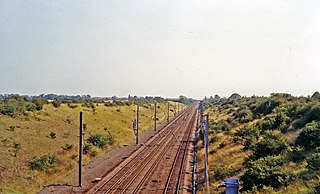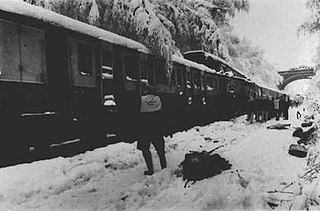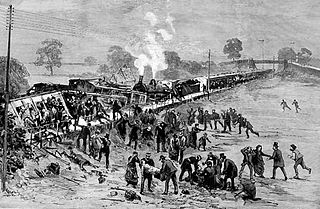
The Colwich rail crash occurred on the evening of Friday 19 September 1986 at Colwich Junction, Staffordshire, England. It was significant in that it was a high speed collision between two packed express trains. One driver was killed, but no passengers were killed, because of the great strength of the rolling stock involved, which included examples of Mk1, Mk2 and Mk3 coaches.

The Nuneaton rail crash occurred on 6 June 1975, on the West Coast Main Line just south of Nuneaton railway station in Warwickshire, England.
On 8 March 1996, a Transrail freight train travelling from Mossend in Glasgow to Willesden in London, derailed after an axle on a wagon carrying liquid carbon dioxide failed due to fatigue at Rickerscote 1.4 miles (2.2 km) south of Stafford. Almost immediately after the derailment, a Travelling Post Office mail train hauled by a Rail Express Systems British Rail Class 86 electric locomotive collided with a section of the derailed freight train on the adjacent line and fouled the path of the TPO mail train. One person, a mail sorter, was killed in the crash and twenty others including the driver of the mail train were injured.

The Sunshine rail disaster occurred on 20 April 1908 at the junction at Sunshine railway station when a Melbourne-bound train from Bendigo collided with the rear of a train from Ballarat. 44 people were killed and over 400 injured, almost all of them from the Ballarat train, as the Bendigo train was cushioned by its two locomotives.
The Norton Fitzwarren rail crash occurred on 4 November 1940 between Taunton and Norton Fitzwarren in the English county of Somerset, when the driver of a train misunderstood the signalling and track layout, causing him to drive the train through a set of points and off the rails at approximately 40mph. 27 people were killed. The locomotive involved was GWR King Class King George VI which was subsequently repaired and returned to service. A previous significant accident occurred here on 10 November 1890 and the Taunton train fire of 1978 was also within 2 miles.

Luton railway station is a railway station located in the town centre of Luton, Bedfordshire, England. The station is about three minutes' walk from the Arndale Shopping Centre. It is situated on the Midland Main Line and is operated by Thameslink.

Stafford railway station is the only railway station in Stafford, Staffordshire, England, and is the second busiest railway station in Staffordshire, after Stoke-on-Trent. The station serves the county town, as well as surrounding villages. The station lies on the junction of the Trent Valley Line and the Rugby-Birmingham-Stafford Line.

Over the latter years of the 19th and early years of the 20th centuries, Penistone in Yorkshire gained a name as an accident black-spot on Britain's railway network; indeed, it could be said to hold the title of the worst accident black-spot in the country. The main line through the town was the Woodhead route of the Manchester, Sheffield and Lincolnshire Railway between Sheffield Victoria and Manchester, London Road. The line was heavily graded with a summit some 400 yards inside the eastern portal of the Woodhead tunnel.
The Thirsk rail crash happened at Manor House signal box on 2 November 1892, on the North Eastern Railway about 3 miles (4.8 km) north of Thirsk railway station in the North Riding of Yorkshire, England.
The Darlington rail accident occurred on the evening of 27 June 1928 when a parcels train and an excursion train collided head on at Darlington Bank Top railway station in County Durham, England. The accident was caused by the parcels train driver passing a signal at danger, due to misunderstanding the signalling layout in an unfamiliar part of the station. This accident resulted in the deaths of 25 people and the serious injury of 45 people.

Henley-in-Arden is a railway station serving the small Warwickshire town of Henley-in-Arden, England. It is on the North Warwickshire Line between Birmingham and Stratford-upon-Avon.

The Spa Road Junction rail crash was an accident on the British railway system which occurred during the peak evening rush hour of 8 January 1999 at Spa Road Junction in Bermondsey, southeast London.

The Abbots Ripton rail disaster occurred on 21 January 1876 at Abbots Ripton, then in the county of Huntingdonshire, England, on the Great Northern Railway main line, previously thought to be exemplary for railway safety. In the accident, the Special Scotch Express train from Edinburgh to London was involved in a collision, during a blizzard, with a coal train. An express travelling in the other direction then ran into the wreckage. The initial accident was caused by:

The Seer Green rail crash occurred on the morning of 11 December 1981 near Seer Green, Buckinghamshire, England between two four-car Class 115 diesel multiple units, killing one driver and three passengers.

The 1984 Eccles rail crash occurred on 4 December 1984 at Eccles, Greater Manchester, when an express passenger train collided at speed with the rear of a freight train of oil tankers. The driver of the express and two passengers were killed, and 68 people were injured. The cause of the accident was determined to be that the driver of the express train had passed a signal at danger.

The Hexthorpe rail accident occurred on 16 September 1887 at Hexthorpe railway platform some 1.5 miles (2.4 km) west of Doncaster on the South Yorkshire Railway line to Sheffield and Barnsley. The platform was situated within a block section between Hexthorpe Junction and Cherry Tree Lane and so had no signals of its own. The railway platform was a simple wooden structure on the Doncaster - bound line usually used for the collection of tickets from the many trains arriving in the town for the St. Leger race meeting.

The Knowle and Dorridge rail crash was a fatal rail crash that occurred at Dorridge railway station in the West Midlands, England, on 15 August 1963. Three people died in the crash after a signalman's error routed a small freight train into the path of an express passenger train which slowed but could not stop before colliding with it.

The King's Cross railway accident occurred on 4 February 1945, at London King's Cross railway station on the East Coast Main Line of the London & North Eastern Railway. Two passengers were killed and 25 injured, as well as the train attendant.
The Slough rail accident happened on 16 June 1900 at Slough railway station on the Great Western Main Line when an express train from Paddington to Falmouth Docks ran through two sets of signals at danger, and collided with a local train heading for Windsor. Five passengers were killed; 35 were seriously injured, and 90 complained of shock or minor injuries
The Doncaster rail crash (1947) was a railway accident that occurred just south of Doncaster station at Bridge Junction. A train was signalled onto an occupied line and the collision resulted in 18 deaths and 188 injuries. Both trains and signalling were operated by the London & North Eastern Railway (LNER).



















